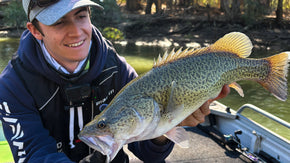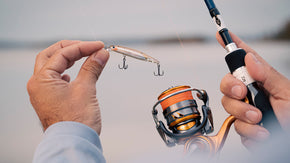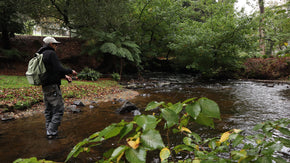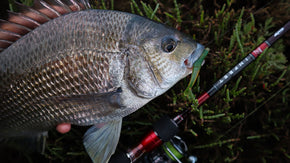Posted 25th January 2023
Landbased Series: Adelaide Region


By Robert Thornton
Adelaide is on the smaller side for an Australian state capital, with a population of only about 1.4 million people – about a quarter of Greater Sydney. Despite its modest size, this city well and truly punches above its weight, consistently churning out world-class sporting, cultural and fine dining experiences for tourists and locals.
Something that often goes unnoticed though is the quality of the fishing, where even those confined to the land can enjoy an excellent variety of species. From hard-fighting migratory pelagics, to iconic freshwater favourites (not to mention the very tasty shelled critters that dwell near the shoreline), Adelaide really does have it all.
Like any fishing destination though, it helps to have a basic idea of where you want to go, and the species you wish to target. Plentiful though the sea life may be, it will usually take a targeted approach to bring it unstuck. Planning is the key to urban angling, particularly if you’re landbased, but the good news is that even in a smaller city like Adelaide, if your plan A fails, there’s usually something biting somewhere else. Once you know a city’s waterways and what lives in them well enough, it’s then a simple task for you to grab some gear, get out the door and straight into a bit of urban angling.
Fishing in our cities is about utilising small pockets of time you have available to you, and for many seasoned city slickers it’s before or after work or school. Because of this it makes sense to start by exploring the waterways nearby where you live, work or study. It may take a few visits to a particular spot to understand the fish’s habits and work out how to catch them, but by spending an hour here and an hour there, and you’ll soon have an area wired, and you can then move on and unlock more local secrets.
 Landbased Kit
Landbased Kit
As we’ve discussed in the other landbased city fishing blogs, your tackle storage is a very important step in preparation. A car is an extremely useful tool for the landbased fisher, both for transport and extra tackle storage, but it’s not the be-all-end-all. Adelaide’s public transport network and various bikeways make landbased angling possible for those without a car. Without a car you’ll be pretty much confined to what you can carry on you, but that shouldn’t be too much of an issue!
Daiwa’s Guide Waist Bag and Sling Bag offer good compact storage options that can be carried around comfortably, and are designed to hold a selection of tackle and accessories for avid shorebased anglers.
The Soft Plastic Wallet and Egi Wallet are designed to slide inside carry bags, and will make sure your soft plastics and squid jigs don’t get tangled up with one another, and can prevent them banging around or even getting mixed up and melting (as some soft plastics do). Keeping your tackle storage neat and compact will go a long way to ensuring you have an enjoyable experience.
The Trout Shoulder Bag is a good option for serious landbased lure anglers, and although its designed for the trout gang, anyone who likes to carry a compact but broad selection of tackle and accessories will love this piece of kit. With a plier holder, mesh pockets, multiple Velcro pockets, multiple toggles, and a sealed zipper pocket, this bag will keep things safe and protected, but also within easy reach.
If you want to keep your options open and carry a bit of extra gear, the Guide Backpack is a gamechanger. Anglers planning to walk a little further with extra gear will love this pack, and what’s more, the Guide Backpack, Guide Waist Bag and Guide Phone Pouch can be combined in a bag-on-bag system!
Of course, Daiwa have a range of storage and luggage options perfect for landbased fishing, so make sure you check them out! Landbased Tackle
Landbased Tackle
There are a few different species available to anglers in Adelaide’s metro, and your target species will determine what sort of gear is best.
Chasing smaller species such as bream, calamari, King George whiting, snook, and most freshwater species is best done with finesse gear, and a 2-4kg spin rod and 2500 reel is a great all-round option. An 20 AIRD-X and AIRD LT rod and reel combo is absolutely perfect, and performs well above other combos in this price range. The 701LXS model is great for general angling, while the 782LRS is a better option for those who want a little extra rod length for casting distance and reach. Good quality 6-10lb braid and a fluorocarbon leader in a similar poundage is a good way to complete this set up.
Anyone wishing to chase salmon and mulloway in the surf might want something more suited to this style of fishing. Daiwa’s 21 Over There series are the ideal rods for casting lures from the beach or rocks – styles of fishing that Adelaide offers. Spin reels in the 3000-4000 range and lines around 10-15lb will ensure you don’t run into too much trouble with the larger predators that lurk in the waves.
Lastly, given the recent improvement in accessibility of the nearby reservoirs, you might want to think about your freshwater options too! Smaller species like trout, redfin and silver perch can be handled easily on a light spin rod, however the Murray cod and callop (golden perch) that are now stocked in these reservoirs aren’t always so small. Those specifically targeting cod might want a baitcast set up, and there’s none more versatile than the Tatula 100 reel and 19 Tatula Baitcast rod. A medium-light or medium weight rod will help you to cast the larger lures required to fool Murray cod, but also allow you to keep your options open and target other species like callop, silver perch and redfin.
Lures and Baits
People often agonize over which lures to buy, and then which to pack when they head out on an adventure, but if you have a plan you shouldn’t need many. Adelaide local and Daiwa Pro Team member Joshua Davey has a few favourites that consistently perform across the board for him.
“The number one for me would be the 75mm Double Clutch,” he says, “You can fish it off jetties, landbased and in the estuaries.”
“They’re good for bream, salmon, snook and most bread-and-butter species.”
Other ‘must-haves’ for Joshua include the BaitJunkie 2.5” Grub and Infeet Slippery Dog in both the 65 and 80 sizes. These lures work really well for the same species, and also yellowfin whiting especially, and will also perform well in the freshwater.
“The 5” BaitJunkie Jerkshads are good off the jetties if you’re chasing salmon and mulloway,” he says, “and metal slugs are always a useful lure to have on hand.”
“All metro jetties fish well for squid,” he continues, “it’s a big thing here in spring and summer, and often the jetties are packed.”
With this in mind, it’s definitely worth have a few jigs on hand, and a selection of sizes and colours from the Emeraldas Peak, Nude and Dart ranges will have you well prepared. Some favourite models are the Peak 3.0 and Nude 30.
Bait fishing is also popular throughout South Australia, and is undeniably effective across the board. Light weight running sinker rigs and small paternoster rigs are simple but deadly, especially off piers and in the surf.
“Pilchards are probably the number one bait,” Joshua says, “you can use them for salmon, mulloway, bream and a heap of others because they’re just so versatile.”
“Beachworms are another popular bait, especially in the surf,” he continues, “And third for me would have to be squid; you can catch anything on it – whole or in pieces.”
 Adelaide Fishing Spots
Adelaide Fishing Spots
While Adelaide’s fisheries may not be as well funded as other states, there is adequate access and facilities to sample its goods from the shore. With good quality beach, pier, estuary and freshwater fishing within easy reach of the CBD, there’s plenty of opportunities to bend a rod in the city of churches.
Bread-and-Butter
Adelaide has heaps of areas to chase species like black bream, yellowfin whiting, squid, snook, garfish and tommy ruff (Australian herring).
“If I was after bream, I’d be looking in the Onkaparinka River, West Lakes, and the Port Adelaide River,” Joshua explains, “Pretty much wherever you can get in and have a few casts is a good spot for bream.”
“Most bream fisheries around here tend to fish best from the shore anyway,” he continues, “Most of our estuary systems are too small for boats and even kayaks, and are that skinny that it’s easy to cast to other side.”
In these same areas, particularly closer to the ocean, it can also be worth prospecting over any nearby shallow flats with a Slippery Dog for yellowfin whiting.
“For gars and tommy ruff, the Port Noarlunga Jetty, Semaphore Jetty, and Brighton Jetty are pretty reliable spots,” he says, “and calamari are pretty abundant through SA, but Noarlunga, Brighton, and a place called Marino Rocks are particularly good areas.”
“If you can find clear water and access to seagrass, though, you should be able to find a few calamari.”
“In these same areas you’ll also usually find snook, which are a popular target down here, and they eat lures and baits.”
“King George whiting are also a possibility from some of the jetties, however they are not a consistently viable landbased target for Adelaideans.
 Pelalgics and Bigger Estuary Predators
Pelalgics and Bigger Estuary Predators
If you’re after something to test the heavier gear, you’re not forgotten about. Salmon cruise through this area year-round, however winter is the best time to intercept one of the schools.
“Port Noarlunga Jetty and the neighbouring Southport Beach, along with Waitpinga Beach would be my pick for landbased salmon spots,” Joshua says, “I find the 5” Jerkshads are good off the jetty because you can sink them down a bit.”
“I prefer using metal slugs off the beaches.”
Mulloway are another popular target around Adelaide, and they are surprisingly accessible for landbased anglers.
“All of our estuaries have good mulloway fishing, with the Onkaparinka, West Lakes and the Port River excellent spots,” Joshua says, “I usually fish with pilchards, 5” Jerkshads, or Double Clutches in the 75 or 95 sizes.”
“Our surf fishing for mulloway just south Adelaide is very good too,” he continues, “Goolwa Beach would be my pick.”
In years gone by snapper have been a popular target around Adelaide, however the controversial snapper ban has been extended until 2026, so they cannot legally be targeted in this region.
 Freshwater
Freshwater
In recent years local reservoirs have opened to the public and received stockings of popular freshwater targets, both native and introduced.
“Within an hour of the CBD we have half a dozen reservoirs that offer good fishing,” Joshua explains.
Most of these lakes have Murray cod, callop (golden perch) and silver perch, with some reservoirs further afield like Bundaleer also holding good population of trout (rainbow and brown). Invasive species like carp and redfin are ever-present in most lakes, but offer good sport as well. All these species respond to a variety of lures, flies and baits.
“Happy Valley, Warren, South Para and Myponga reservoirs have cod, goldens and silver perch in them,” Joshua says, “there’s also good populations of redfin in them too.”
Walking around the margins of these lakes with a handful of lures, or even just stationing up in a likely area for a bit of bait fishing are both good ways to fish these lakes. Once you’ve made a few trips to a particular reservoir, you should be able to put together an idea of the techniques required to catch the different species in them.
Bear in mind that a permit is required to fish in these reservoirs, and that the revenue from these permits is what makes it possible to keep them stocked.
 Wrap-up
Wrap-up
Adelaide is something of a quiet achiever on the fishing front. People in other cities might not hear a lot about it, but they would probably be surprised at the quality of the fishing on offer, not to mention the diversity of options!
If you live in this great city or are travelling through, remember that you don’t need a boat to enjoy its unique fisheries. Jump in the car, bus, train, tram, or even on a push bike and go find out for yourself!















